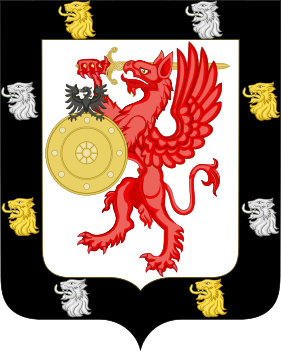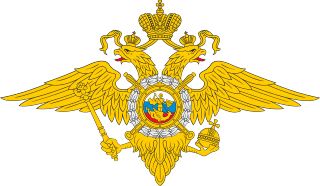Related Research Articles

The House of Romanov was the reigning imperial house of Russia from 1613 to 1917. They achieved prominence after the Tsarina, Anastasia Romanova, was married to the First Tsar of Russia, Ivan the Terrible.

Vladimir Ivanovich Vernadsky or Volodymyr Ivanovych Vernadsky was a Russian, Ukrainian and Soviet mineralogist and geochemist who is considered one of the founders of geochemistry, biogeochemistry, and radiogeology.

Vladimir I Sviatoslavich or Volodymyr I Sviatoslavych, also known as Vladimirthe Great or Volodymyr the Great, was Prince of Novgorod, Grand Prince of Kiev, and ruler of Kievan Rus' from 980 to 1015.

The Ministry of Internal Affairs of the Russian Federation is the interior ministry of Russia.

Nikolay Ivanovich Bobrikov was a Russian general and politician. He was the Governor-General of Finland and the Finnish Military District from 29 August [O.S. 17] 1898 to 16 June [O.S. ] 1904 during the early reign of Emperor Nicholas II, and was responsible for the Russification of Finland. After appointment as the governor-general, he quickly became very unpopular and was assassinated by Eugen Schauman, a Finnish nationalist born in Kharkiv.

The Imperial Order of Saint Prince Vladimir was an Imperial Russian order established on 3 October [O.S. 22 September] 1782 by Empress Catherine II in memory of the deeds of Saint Vladimir, the Grand Prince and the Baptizer of the Kievan Rus'.
Vladimir may refer to:

Grand Duke Kirill Vladimirovich of Russia was a son of Grand Duke Vladimir Alexandrovich of Russia, a grandson of Emperor Alexander II and a first cousin of Nicholas II, Russia's last tsar. He was also the uncle of Princess Marina of Greece and Denmark and great-uncle of Prince Michael of Kent.

Grand Duke Vladimir Kirillovich of Russia was the Head of the Imperial Family of Russia, a position which he claimed from 1938 to his death.

Grand Duchess Maria Vladimirovna of Russia has been a claimant to the headship of the Imperial Family of Russia since 1992. Although she has used Grand Duchess of Russia as her title of pretence with the style Imperial Highness throughout her life, her right to do so is disputed. She is a great-great-granddaughter in the male line of Emperor Alexander II of Russia.

Monomakh's Cap, also called the Golden Cap, is a chief relic of the Russian Grand Princes and Tsars. It is a symbol-crown of the Russian autocracy, and is the oldest of the crowns currently exhibited at the Imperial treasury section of the Kremlin Armoury. Monomakh's Cap is an early 14th-century gold filigree skullcap composed of eight sectors, elaborately ornamented with a scrolled gold overlay, inlaid with precious stones and pearls, and trimmed with sable. The cap is surmounted by a simple gold cross with pearls at each of the extremities.

Grand Duke Vladimir Alexandrovich of Russia was a son of Emperor Alexander II of Russia, a brother of Emperor Alexander III of Russia and the senior Grand Duke of the House of Romanov during the reign of his nephew, Emperor Nicholas II. He was also the great-grandfather of Grand Duchess Maria Vladimirovna of Russia, Prince Edward, Duke of Kent, Princess Alexandra, The Honourable Lady Ogilvy, and Prince Michael of Kent and the great-great grandfather of both Grand Duke George Mikhailovich of Russia and actress Catherine Oxenberg.

Vladimir Lukich Borovikovsky was a prominent Russian Imperial artist of Ukrainian Cossack background, who served at the court of Catherine the Great and dominated portraiture in the Russian Empire at the turn of the 19th century.

The Russian Geographical Society (RGO) is a learned society based in Saint Petersburg, Russia. It promotes geography, exploration and nature protection with research programs in fields including oceanography, ethnography, ecology and statistics.

The Military Academy of the General Staff of the Armed Forces of the Russian Federation is the senior staff college of the Russian Armed Forces.

The Imperial Order of Saint Stanislaus, also spelled Stanislas or Stanislav, is a Russian dynastic order of knighthood founded as Order of the Knights of Saint Stanislaus, Bishop and Martyr in 1765 by King Stanisław II Augustus of the Polish–Lithuanian Commonwealth. In 1831 after the downfall of the November Uprising, the order was incorporated into the Chapter of Russian Orders as part of the honours system of the Russian Empire by Emperor Nicholas I of Russia.
The Imperial Order of Saint Michael the Archangel, is a dynastic order of knighthood instituted in 1988 by Grand Duke Vladimir Kirillovich, claimant to the headship of the former Russian Imperial House.
The Imperial Russian Army and the Imperial Russian Navy used ranks and rank insignia derived from the German model. However, the entire rank system was also closely connected to the Russian military traditions. In the aftermath of the Russian Revolution, the Red Army abolished the entire Imperial system of ranks and rank insignia, while military units and formations of the opposing White movement retained the Imperial rank system until 1923.
The 1st Guards Corps was a corps-level command in the Russian Imperial Army that existed in the decades leading up to and during World War I. Stationed in St Petersburg, it included some of the oldest and best known regiments of the Emperor of All Russia's Imperial Guard.
References
- ↑ "Vladimir Chikolev". TheFreeDictionary.com. The Great Soviet Encyclopedia (1979). Retrieved 3 March 2021.